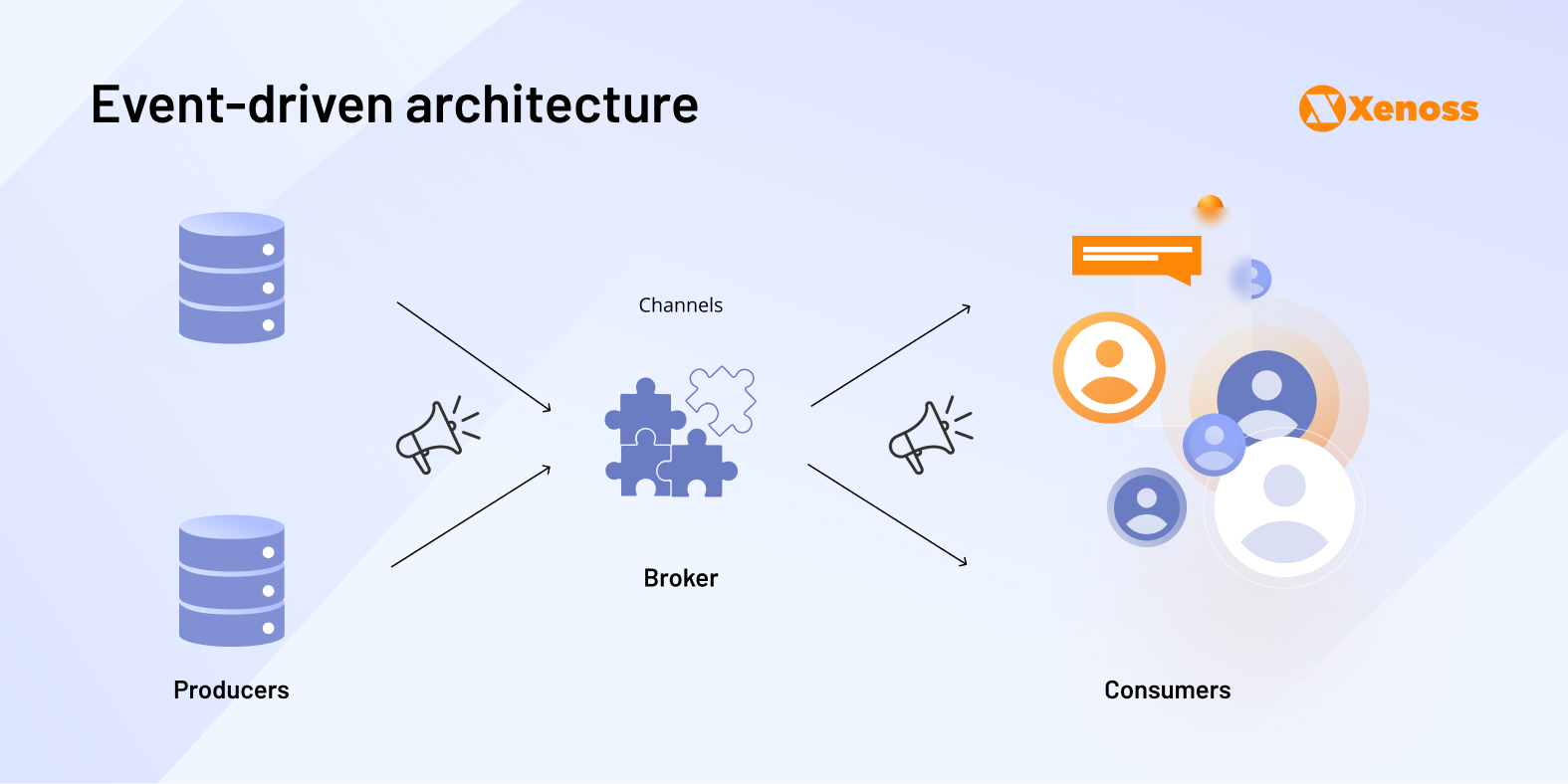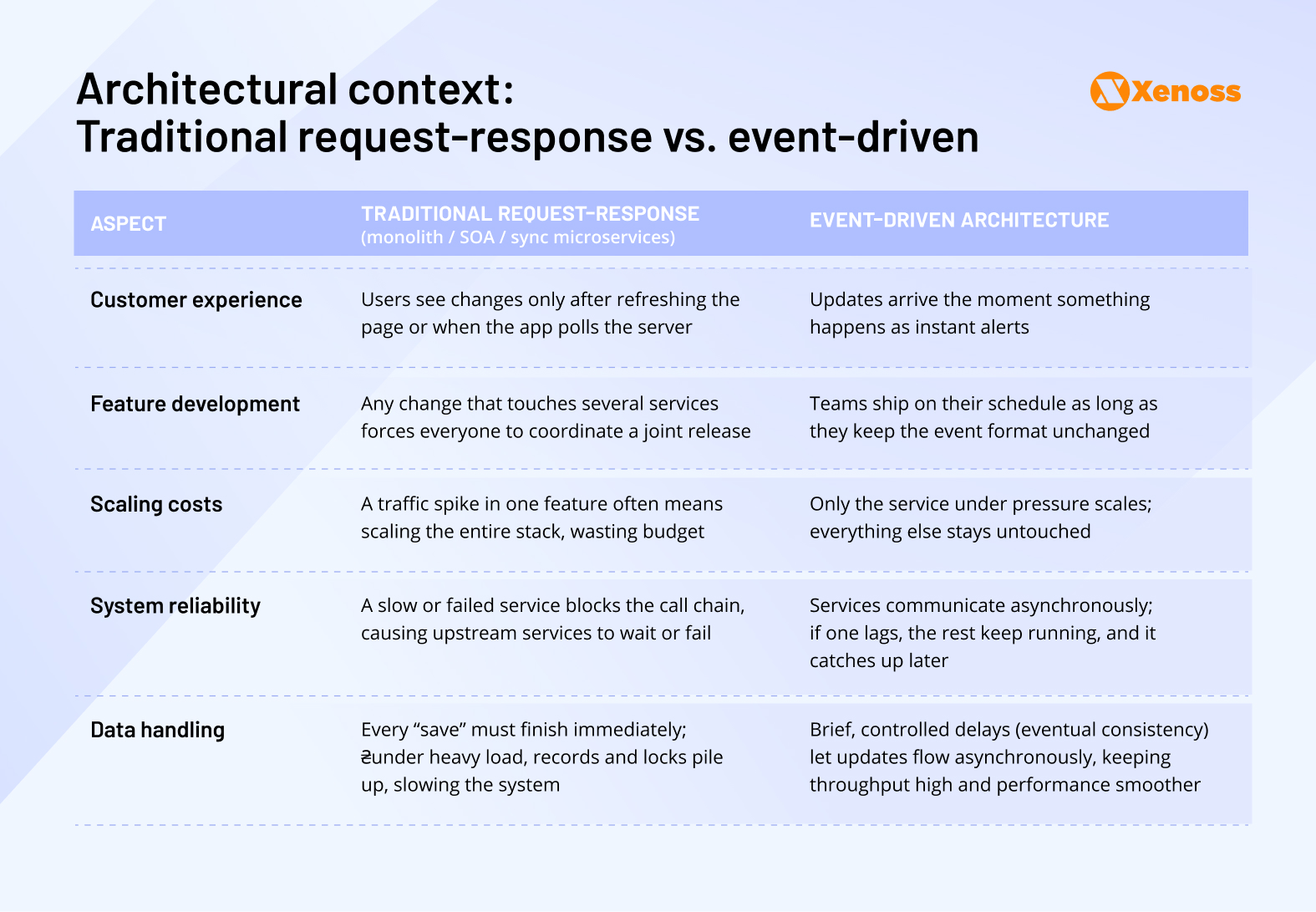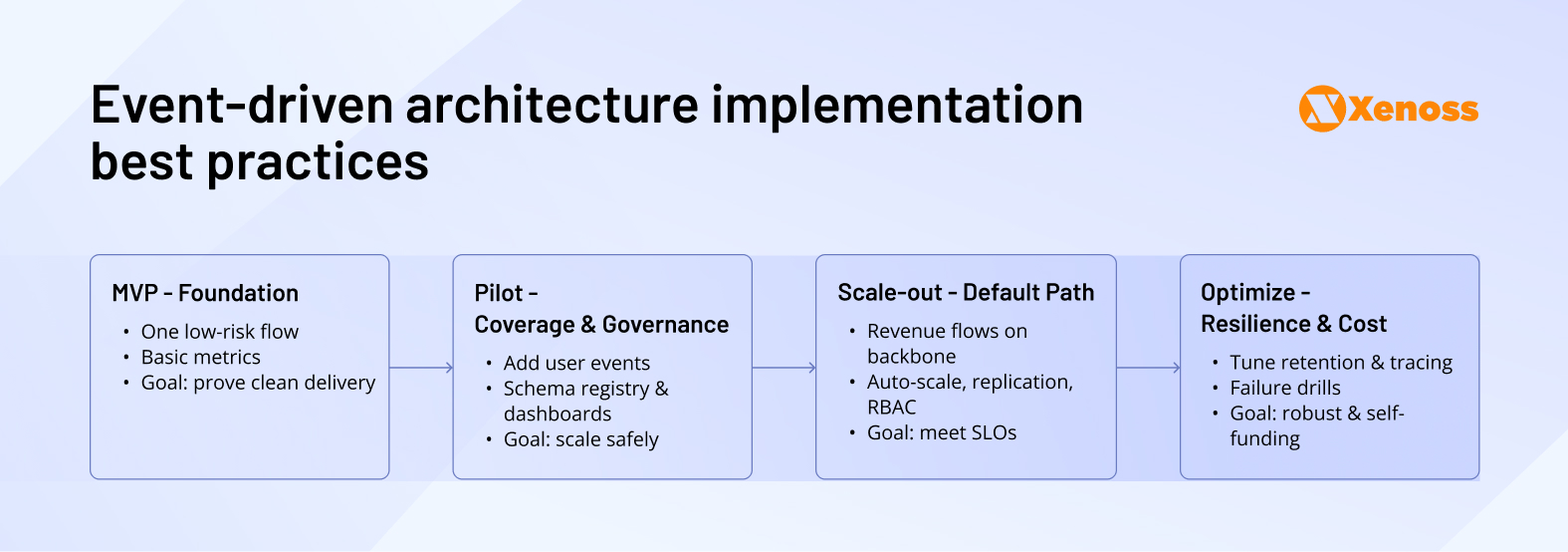Have you ever watched a modern automotive assembly line during peak production? Workers scan a barcode as each chassis moves past, and every station knows exactly what to do. The engine team sees they need a V6 turbo, the electrical harness crew prepares the premium package wiring, and the paint crew knows to spray metallic blue in 20 minutes. Components flow when they’re ready, and everything comes together without a central coordinator frantically managing every step. If your product architecture works like this, congratulations, you’re already living the event-driven dream.
However, many product stacks still operate like a noisy factory, where services constantly check databases and wait for responses, causing slowdowns and failures under pressure. Event-driven architecture replaces this with clear signals. When a service finishes its task, it sends a signal. Other services respond immediately without waiting or polling. The result is an assembly-line rhythm for software: autonomous teams work in parallel, feature lead times shrink, and demand spikes are absorbed without requiring a complete overhaul.
Understanding event-driven architecture (EDA)
EDA makes your product stack behave more like a responsive conversation: ready to listen, react in real time, and evolve based on what happens inside the system without lengthy coordination cycles. This helps build faster, smarter, and more customer-focused experiences using scalable and flexible technology.
Key EDA concepts the product leader would want to know
- Events are the raw facts of business activity. They double as the “source of truth” for dashboards, audits, and downstream automation.
- Producers and consumers are the team-owned services, the “storytellers” that send and the “responders” that react to those events. Because they interact asynchronously, each squad can deploy, scale, or refactor without waiting for a company-wide release train.
- Event broker delivers every message to the right place, like a “postal service”, reliably and in order, without the sender or receiver needing to know each other’s internals.
- Contracts or schemas act as the shared language. They spell out exactly what data sits in each event, allowing teams to communicate and integrate independently without accidental breakage.
The typical EDA flow
- An event occurs (e.g., an item added to the cart)
- An event producer (e.g., checkout service) emits an event message describing this change (with the item ID, quantity, and timestamp)
- An event broker receives, filters, and routes the event based on pre-defined policies or subscriptions ( e.g., to inventory, promotions, and analytics)
- Consumer services receive the event and execute relevant business logic (e.g., updating inventory, sending notifications, recalculating discounts, logging behavior), often asynchronously and in parallel.

No step blocks another, so a glitch in one service never cascades to another. Because events are fire-and-forget and consumers pull them only when ready, an EDA layer glides over your existing stack. REST endpoints, databases, or third-party tools can act as producers, consumers, or both, letting you modernize applications and workflows without abandoning what already works. Viewed this way, EDA becomes a tool for structuring product work around real business moments. It enables teams to speed up delivery, gain real-time insights, and prevent changes from becoming bottlenecks.
Product-level impact: Synchronous vs. event-driven models
Event-driven architecture is not a new concept. Forrester points out that computers have responded to stimuli since the 1950s, from the hardware interrupts of the UNIVAC to the complex-event processing in the 2000s. GUI event loops, high-frequency-trading engines, and today’s SaaS platforms all ride on the same principle: publish an event, let whoever cares react, and keep the publisher blissfully unaware of the consumer’s state.
What is new is the pressure on modern product stacks. Synchronous SOA (Service-oriented architecture), ETL (Extract, Transform, Load), and batch pipelines still assume that data can wait for the next poll or nightly job. Mobile push alerts, real-time fraud detection, and omnichannel personalization say otherwise.
Although the entire philosophy of system design runs far deeper, the comparison below distills the practical trade-offs between synchronous, request-response architectures, such as monolithic, SOA, or tightly coupled microservices, and an event-driven approach.

Why product teams should care about EDA
62% of product teams use event-driven architecture as their primary architectural pattern, making EDA the second in popularity after microservices (67%).
When your product grows beyond a handful of services, traditional architectures force teams into a web of dependencies where every feature release becomes a complex orchestration exercise. Teams spend more time coordinating releases than building features, deployment windows require alignment across multiple services, and a single team’s delay cascades through the entire pipeline. This cross-team friction directly limits their ability to respond to customer requests, ship features when promised, and adapt product direction based on user feedback.
EDA breaks this bottleneck by allowing your teams to develop, test, and deploy autonomously. Systems stay connected through clear event contracts, which speed up feature rollouts and reduce the risks of interdependent releases. For product leaders, this means measurable improvements in development velocity and the ability to scale teams without proportionally increasing coordination costs.
Common product challenges that EDA addresses
Product teams today face a constellation of interconnected challenges that stem from the increasing complexity of modern software systems. When user traffic grows unexpectedly, whether through viral campaigns or seasonal peaks, traditional architectures often force teams into over-provisioning their entire platform, driving up cloud spend while still risking slow performance when a single feature becomes a hotspot.
These scaling issues compound with another persistent problem: release delays caused by cross-team dependencies. A slight change in the checkout process can stall until catalog, payments, and analytics teams finish their synchronized updates, stretching what should be two-week sprints into month-long release trains. This tight coupling between services creates a domino effect that slows innovation and frustrates development teams.
Meanwhile, customer expectations continue to evolve toward real-time experiences. Users now expect live order status updates, instant alerts, and synchronized sessions across all their devices. Traditional request/response APIs often leave customers staring at stale data or constantly refreshing their browsers, creating friction in what should be smooth interactions.
The architecture that creates these user experience problems also amplifies the impact of failures. A single bug or even a slow database call in one service can cascade through tightly linked components, transforming a minor issue into a multi-team outage with a significant blast radius. This fragility makes teams hesitant to experiment and innovate. Testing an A/B feature or soft-launching functionality demands a full deployment and rollback plan, causing many promising ideas to languish in the backlog rather than reaching users who might benefit from them.
When problems do occur, teams struggle with an opaque event history that makes audits and compliance difficult. Proving “who did what, when” means piecing together scattered logs and screenshots, a process that consumes analyst hours and raises significant risk when regulators ask tough questions about data handling and user privacy.
As product surfaces expand, these challenges create growing coordination overhead. Every new feature adds more meetings, status updates, and dependency tracking time that could be better spent building customer value. Teams find themselves spending more time managing complexity than creating solutions.
Finally, the difficulty of meeting changing data governance rules adds another layer of complexity. New privacy regulations require clear data lineage and retention controls; however, retrofitting these guarantees into legacy integrations proves to be manual, brittle, and error-prone. Teams need architectures that can adapt to compliance requirements without requiring extensive rework.
These common challenges are prompting product teams to adopt event-driven architecture, which eases several pain points on their way to making products more resilient and scalable.
Benefits of EDA for product teams
EDA transforms high-friction release cycles and scaling headaches into a predictable, repeatable engine for fast, low-risk, and logical product evolution, so your teams can focus on delivering results instead of untangling dependencies. The commonly recognized benefits of EDA for product teams include:
Faster time-to-market. Each squad ships when the feature is ready because event contracts decouple releases. Lead time for changes shrinks from “every few weeks” to “whenever it’s built”, letting you test ideas sooner and out-iterate competitors.
Integrated, cost-efficient scalability. Producers and consumers scale independently as traffic ebbs and flows. You handle holiday surges or viral spikes by adding capacity only where it’s needed, avoiding blanket over-provisioning and keeping cloud bills lean.
Complete, always-on audit trails. Every state change is captured in an immutable log that can be replayed on demand. Compliance reports, root-cause analysis, and post-incident reviews move from days of log-digging to minutes of straightforward queries.
Lower operational overhead. Small, decoupled services result in clearer ownership and fewer cross-team conflicts. On-call engineers debug a contained slice of the product, and your ops budget tilts toward intelligent automation instead of manual coordination.
Real-time customer experiences. Services react to events in milliseconds, delivering instant notifications, live dashboards, and personalized journeys. Users see fresher data and snappier interfaces — the drivers of higher engagement and retention.
- Event-centric product workflow. Versioned events serve as reusable building blocks: teams plan in small increments, integration risks are surfaced early via contract mocks, and new hires ramp up quickly, all without adding more status meetings.
- Release safety and reliability. Independent services run on replayable event logs, so one-click rollbacks are simple and failures stay contained, minimizing risks and customer-visible incidents. Outages remain local, uptime SLAs hold, and teams ship more often and with greater confidence.
How EDA transforms product team dynamics
Event-driven architecture reshapes how product teams collaborate and operate, creating a more productive environment. When teams adopt EDA, they gain a clear cross-team alignment through versioned event definitions that serve as living documentation and a single source of truth. Rather than struggling with ambiguous integration points, your product experts can plug into the same stream of business events, understand ownership at a glance, and stay synchronized with fewer overwhelming updates or extra status meetings.
This improved coordination naturally leads to stronger end-to-end ownership within product teams. The same teams who trial and ship features become responsible for their performance metrics and user impact, creating a direct connection between development decisions and customer outcomes. This ownership model supports faster resolution of customer issues, drives product quality improvements through direct feedback loops, and ensures accountability remains with the team that built each feature.
One of the important aspects is that EDA creates more capacity for low-risk innovation by reducing coordination overhead. When teams no longer need to manage complex release dependencies, product experts can redirect their time from managing releases to building customer-facing features. This shift allows roadmaps to advance faster, enables resources to move from reactive fixes to strategic initiatives, and makes key business metrics more visible across the organization.
Smooth EDA adoption: Roadblocks and solutions
Adopting an EDA approach offers real benefits for product teams, but it also introduces new challenges in integration management, skill requirements, data governance, and monitoring.
The first hurdle teams encounter is architectural complexity. As each service begins to publish and listen for events, the number of data contracts can skyrocket, creating a web of dependencies that becomes difficult to manage. To prevent this from snowballing into an unmanageable situation, teams should launch EDA with a narrowly scoped pilot and establish a lightweight schema registry that includes clear ownership and governance essentials before scaling to broader implementations.
Transforming the team mindset is equally important. Teams that previously relied on traditional request/response workflows must now design for eventual consistency. This represents a fundamental shift in thinking that can hinder delivery without proper guidance. Organizations can flatten the learning curve by hosting focused workshops and training sessions led by early adopters, maintaining a living playbook of proven patterns as references.
As the architecture expands, security and data governance become critical concerns. Events often carry sensitive customer data that travels across service and regional boundaries, requiring the same level of protection given to core databases. This involves encrypting data both in transit and at rest, limiting access to streams by role, and automating retention and deletion policies to comply with both local and global regulations.
Ultimately, product teams must prioritize observability and effective troubleshooting of issues. In an event-driven system, a single customer action can flow through several brokers and consumer services, making failures hard to spot and diagnose. Success depends on choosing a platform that offers end-to-end tracing, live metrics, and automatic dead-letter queues. With these capabilities in place, issues surface quickly, fixes can be shipped sooner, and the customer experience remains smooth throughout the system’s operation.
Pre-adoption checklist for product leaders exploring EDA
With all its benefits, EDA isn’t universal. It pays off when your product needs real-time responsiveness, seamless scaling, coordinated services, automated compliance, or fast feature releases. Confirm these needs, set clear targets for reliability, flexibility, and cost, and align product, engineering, and compliance on a single roadmap. If those boxes aren’t ticked, a different setup might serve you better for now.
- Anchor the move to clear product KPIs. Establish baseline and target metrics tied to business growth patterns: time-to-value, gross margin, deployment frequency, customer satisfaction (NPS/CES), and customer lifetime value (CLTV). These metrics demonstrate whether event-driven architecture delivers measurable ROI and justifies the investment.
- Validate the product-stage fit. Confirm that your use case rationalizes the added complexity. If your immediate pain points are real-time user experiences, volatile traffic, or multiple independently deployed services, EDA is a solution. For low-volume or early-stage products, a structured modular approach typically delivers faster at a lower cost.
- Secure technical foundation. Commit to an event platform with strong uptime guarantees, comprehensive disaster recovery procedures, and versioned contract management capabilities. These essentials will help you maintain data flow and prevent team bottlenecks.
- Establish data governance early. Assign clear ownership for each event domain and publish standardized naming conventions and retention policies to ensure consistency. Implement automated compatibility checks to prevent “event sprawl” and streamline audit or privacy compliance requirements.
- Ensure end-to-end visibility. Implement journey-level tracing and exception monitoring before the first event reaches production. This observability foundation shortens incident-resolution times, delivers rapid insights, and safeguards user trust and brand reputation.
- Plan a phased launch. Start with a low-risk, non-critical workflow to prove value and refine implementation standards. Then expand systematically by business domain using “strangler” patterns for legacy system integration. This approach minimizes the impact of potential mistakes and steadily builds internal expertise and confidence.
- Prepare the organisation and culture. Secure executive sponsorship and upskill teams with targeted training. Assign cross-functional event stewards to keep product, engineering, and compliance aligned on naming standards and service-level goals. Consider setting up an internal center of excellence for ongoing knowledge sharing.
- Budget for platform, people, and optimisation. Allocate realistic funds for platform licensing, managed or CloudOps services, expanded SRE/DevSecOps staffing, and the ongoing upkeep of data contracts, security controls, observability, and team skills. These are critical operational expenses that require a standing financial commitment.
- Embed security and compliance. Protect your data and operations by implementing end-to-end encryption, enforcing role-based access control on all event streams, and automating retention policies to meet GDPR, EU AI regulations, or related requirements. Integrate safeguards from day one, so security and compliance scale with your product and avoid costly retrofits later.
Step-by-step EDA implementation plan for product teams
Implementing event-driven architecture requires a strategic, phased approach that reduces operational and financial risks, builds the team’s expertise, scales gradually, and delivers early wins to justify the investment.
MVP: Establishing the foundation
We recommend starting with a single, low-risk event flow: a producer and a consumer connected to an easy-to-monitor feature. Keep the event format concise, add basic logs, and track simple metrics, such as end-to-end latency and delivery success. This experiment gives the product team hands-on practice and proves that events can be transferred cleanly from source to target, yielding the first visible results. Many companies begin their event-driven journey in precisely this way, validating the concept on a modest scale before rolling it out to critical workloads.
Pilot: Expanding coverage and maturity
As the next viable step in your future EDA adoption, launch a pilot project. Add a couple of high-value events that touch visible user journeys. The goal of the stage is to demonstrate that the architecture can handle increased traffic while introducing governance for broader adoption. Stand up a schema registry, simple lag dashboards, and clear access rules so every squad follows the same standards. By the end, all the stakeholders see that EDA can grow safely and predictably.
Scale-out: Making EDA the default path
Move revenue-critical processes onto the event backbone. Enable automatic scaling, replicate data across regions, and strengthen role-based permissions to meet production service levels. This phase aligns capacity with demand while new features launch independently, and performance as well as uptime remain steady.
Optimize: Building for resilience
With core traffic steady, focus on efficiency and hardening. Trim unused storage, tune retention windows, and run failure drills to validate recovery paths. Strengthen identity controls and add deeper tracing to detect issues early, then feed those insights back into your scaling rules and cost models. The result is an event platform that funds itself, withstands outages, and keeps product teams moving fast.

Event-driven architecture examples
Different industries adapt EDA concepts for their specific market context and product strategy. Well-known brands demonstrate how transforming business activities into first-class events helps teams ship faster, scale smoothly, and keep customers happy.
HubSpot: Live chat that never goes offline.
HubSpot’s Conversations tool utilizes a publish/subscribe layer provided by Ably, serving 128,000 businesses and handling approximately 500,000 customer conversations each month. Because each message is just another event on the bus, individual chat services can be upgraded or A/B tested without interrupting support, keeping customer satisfaction scores high while reducing infrastructure spend.
Walmart: Inventory that stays synchronized.
Walmart’s replenishment platform ingests tens of billions of inventory events daily, covering nearly 100 million SKUs, and processes them in under three hours. The same Kafka backbone publishes updates to stores, warehouses, and e-commerce fronts, eliminating oversell scenarios and absorbing holiday spikes without a full-stack redeployment.
Uber: Demand-driven, adaptive mobility.
Uber converts every ride request, GPS signal, traffic alert, and payment update into a real-time event. Because each service listens to its dedicated stream, product teams can tweak pricing formulas, introduce new safety checks, or refine ETA algorithms without taking the marketplace offline. The result is an adaptable, user-friendly platform that provides precise wait-time estimates, transparent fares, and timely guidance for drivers.
Netflix: Personalization that drives growth.
Netflix processes 700 billion daily viewer interactions, powering recommendations through the Keystone pipeline that influence 80% of viewing hours. This event-driven system provides real-time feedback, enabling product teams to quickly iterate and improve content without disrupting streaming, driving faster discovery, longer watch times, and reduced churn.
ING: Instant investor alerts with built-in audit.
ING’s event-driven platform processes about 2,000–12,000 stock price updates each second, triggering instant investment alerts whenever a share crosses a customer’s threshold. The same event log satisfies MiFID II record-keeping requirements, so teams can add new alert features without additional compliance effort. Immediate, personalized notifications strengthen customer confidence and keep traders engaged.
Xenoss: Oilfield efficiency with real-time virtual flow metering.
For the oil and gas business, the event-driven solution by Xenoss streams multi-sensor data in real time and blends physics-based flow models with machine learning to predict flow rates and detect anomalies. It achieved >95 % accuracy, lowered operating costs by 40 %, and cut unplanned downtime by 30 %. Because the software integrates directly with existing SCADA and other monitoring systems, product teams can deploy it quickly, gain continuous insight, and present a clear ROI story to the board.
Final thoughts on scaling your product with EDA
When customers expect immediate interaction, every refresh becomes a referendum on your product’s capabilities. Event-driven architecture transforms each user click, payment transaction, or IoT sensor reading into a live signal that flows through your systems, fueling real-time dashboards, powering AI decisions, and shortening release cycles. Technical elegance becomes the backbone of product resilience, providing the boardrooms with the measurable ROI they demand.
Raw speed alone won’t differentiate your product, though. Tangible value comes from cultural cohesion, product thinking, and solid technical foundations. When product managers see journeys unfold in real time, data engineering experts tap streaming features without workarounds, and customer success teams act on live usage patterns, EDA becomes a business accelerator. Skip that alignment, and a monolith simply morphs into a distributed mess.
If your next growth leap calls for real-time insight, smoother releases, and painless scale, Xenoss can help with a focused pilot that delivers measurable improvements before rolling it out more widely; integrate lineage, governance, and automated rollbacks so the teams ship instead of scrambling and architect once for cloud, hybrid, or on-prem environment and adapt/mature without sleepless nights.


